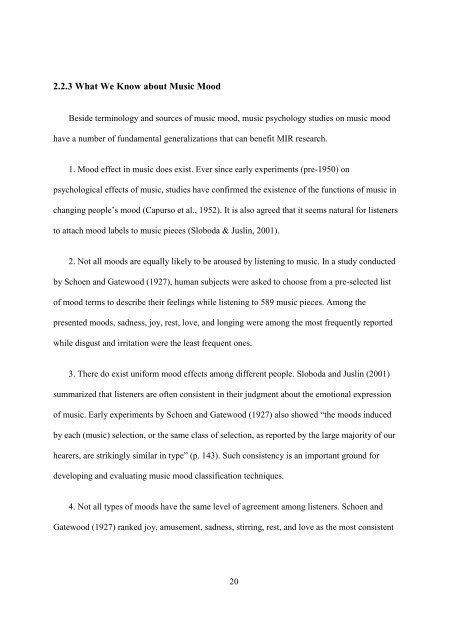improving music mood classification using lyrics, audio and social tags
improving music mood classification using lyrics, audio and social tags
improving music mood classification using lyrics, audio and social tags
Create successful ePaper yourself
Turn your PDF publications into a flip-book with our unique Google optimized e-Paper software.
2.2.3 What We Know about Music Mood<br />
Beside terminology <strong>and</strong> sources of <strong>music</strong> <strong>mood</strong>, <strong>music</strong> psychology studies on <strong>music</strong> <strong>mood</strong><br />
have a number of fundamental generalizations that can benefit MIR research.<br />
1. Mood effect in <strong>music</strong> does exist. Ever since early experiments (pre-1950) on<br />
psychological effects of <strong>music</strong>, studies have confirmed the existence of the functions of <strong>music</strong> in<br />
changing people’s <strong>mood</strong> (Capurso et al., 1952). It is also agreed that it seems natural for listeners<br />
to attach <strong>mood</strong> labels to <strong>music</strong> pieces (Sloboda & Juslin, 2001).<br />
2. Not all <strong>mood</strong>s are equally likely to be aroused by listening to <strong>music</strong>. In a study conducted<br />
by Schoen <strong>and</strong> Gatewood (1927), human subjects were asked to choose from a pre-selected list<br />
of <strong>mood</strong> terms to describe their feelings while listening to 589 <strong>music</strong> pieces. Among the<br />
presented <strong>mood</strong>s, sadness, joy, rest, love, <strong>and</strong> longing were among the most frequently reported<br />
while disgust <strong>and</strong> irritation were the least frequent ones.<br />
3. There do exist uniform <strong>mood</strong> effects among different people. Sloboda <strong>and</strong> Juslin (2001)<br />
summarized that listeners are often consistent in their judgment about the emotional expression<br />
of <strong>music</strong>. Early experiments by Schoen <strong>and</strong> Gatewood (1927) also showed “the <strong>mood</strong>s induced<br />
by each (<strong>music</strong>) selection, or the same class of selection, as reported by the large majority of our<br />
hearers, are strikingly similar in type” (p. 143). Such consistency is an important ground for<br />
developing <strong>and</strong> evaluating <strong>music</strong> <strong>mood</strong> <strong>classification</strong> techniques.<br />
4. Not all types of <strong>mood</strong>s have the same level of agreement among listeners. Schoen <strong>and</strong><br />
Gatewood (1927) ranked joy, amusement, sadness, stirring, rest, <strong>and</strong> love as the most consistent<br />
20
















